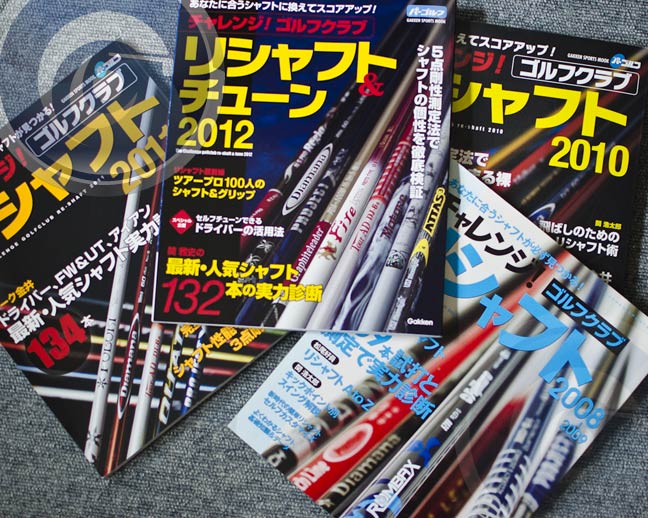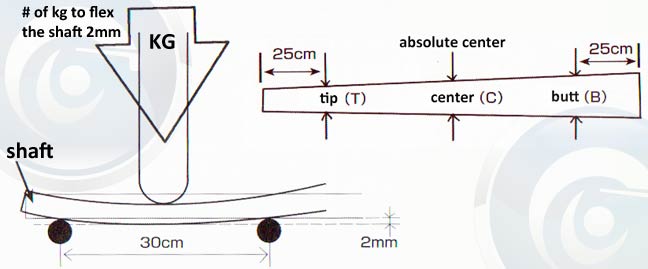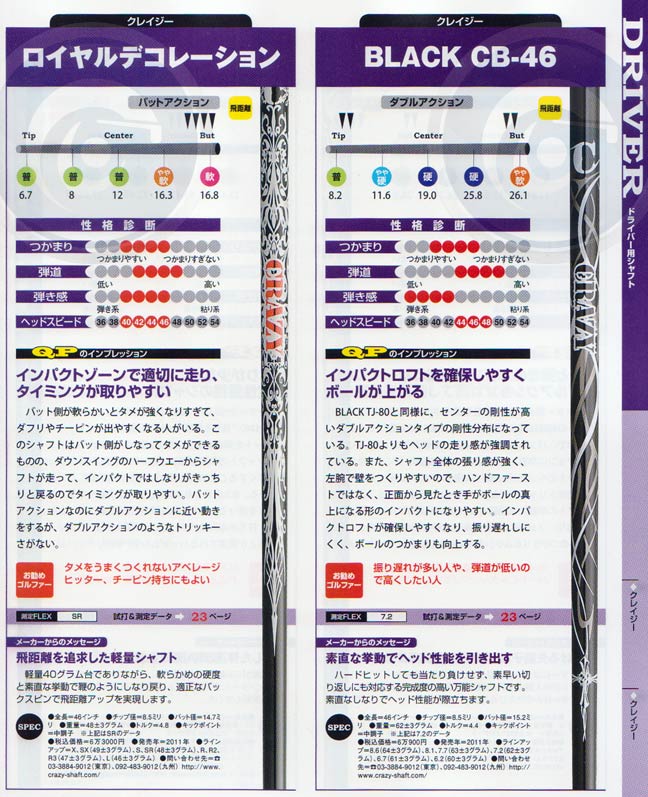Every year I wait for October to roll around so I can get my copy of Gakken’s SHAFT & TUNE publication. I use this “Mook” (they call publications which are a cross between a magazine and a book a Mook here in Japan!) religiously through the year as my shaft bible. While many people talk about basic shaft characteristics like flex and CPM, this 160 page mook takes a look at all the most recent model shafts and delves much deeper than just flex. Every shaft’s performance characteristics are analyzed and compared by installing every single shaft in the same head at the same finished length with the same grip.
Even before they install each shaft, the properly test each shafts rigidity distribution which gives golfers a far more understanding of the way a shaft bends and flexes rather than just looking at CPM. This year the mook used five different points, the tip, tip¢er, center, center&butt and butt sections of each shaft, all measured for flex by seeing how many kg it takes to bend that point 2mm. The Japanese have always been very technical and these kind of measurements have been available for many JDM brand shafts for many years and some of you probably see a smilar style of flex information being used by Miyazaki Shaft outside of Japan as well (they use 4 points and follow IFC Flex code). These measurements done side by side with every shaft model give a better idea of how a shaft flexes under load and ultimately how it bends especially compared with each other.
These numbers can also be used to interpret how a shaft feels ie whippy or boardy. Too many people immediately associate a shaft that feels “whippy” as too soft but many shafts are designed this way for a purpose and depending on their distribution of rigidity. Fitters here in Japan use these numbers religiously especially the tip , center and butt numbers which are used to fit a lot of golfers here depending on the swing styles ie smooth and easy or hard and aggressive swingers. Hard hitters who need more control and stability are better suited with a shaft that has a bigger C/B ratio vs a slicer who needs the head to square and release who would do better with a lower C/B ratio. C/B is of course center over butt flex and the larger the C/B number meaning the stiffer the center area of the shaft is in relation to the butt and in turn the smaller the number meaning the softer the center is in relation to the butt. It’s also good to look at the actual flex at the butt point as this is the section of the shaft that is directly connected to our body and thus relays the most feel (or lack of depending on the butt flex). So in the end picking up a shaft and wobbling and declaring it whippy could only mean the butt is pretty darn stiff and the tip is soft so it creates that wobbly feeling.
Shaft fitters also look at the T/C number or tip over center flex which can dictate the ball flight of a shaft. The smaller the T/C number usually the higher the launch and the bigger the T/C number usually the stiffer the tip and the lower the launch. Simply looking at things like R flex or S flex or even 250cpm in the end don’t really say how a shaft feels or performs.
Besides having tables listing for all the shafts with the flex points, T/C, C/B data and CPM data as well as balance points and swing weight and static weights before and after install, launch data like launch angle, back spin, apex, carry and run etc, the Reshaft & Tune mook also does a writeup on each specific shaft and its characteristics including its ability to square to the ball, the type of trajectory it creates ranging from low to high, it’s feel and recommended swing speed ranges as well as the player it is best suited for. I frequently have this sitting by my desk all throughout the year as it covers not only driver shafts but FW and UT shafts as well as Iron shafts including both steel and graphite. I actually refer to the book many times as well as you may have seen in my blog posts here about club making and shaft fitting.
In the end though, while having a useful resource like this mook, it goes to show how darn difficult it is to choose and find the right shaft. Choosing a great performing shaft for ones swing is down right difficult especially finding THE optimal shaft. We can all obviously swing any shaft, but the right one will optimize performance to the fullest. It’s a difficult science but then again who ever said golf was easy!





Comments 1